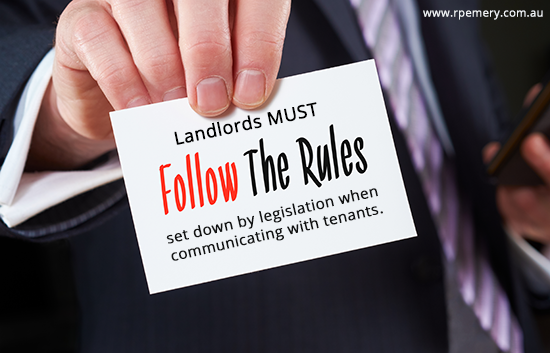Landlords must act quickly and comply with tenancy laws when dealing with non-paying tenants
Tenancy legislation sets out the procedure for how a landlord must deal with a non-paying tenant. This includes giving notices and allowing certain time for the tenant to catch up the rent payments. Specific information must be included in your notices for them to be effective. This information is set out in the legislation and is state based.
By knowing your rights and responsibilities, you can stay one step ahead in the tenancy game, and minimise your losses when dealing with a non-paying tenant.

Careful screening
It goes without saying that you should carefully screen all applicants for your rental property. Do all necessary background checks when selecting a tenant. Our recent article here has more information about the types of background checks eg, credit history and bankruptcy searches you can do.
Positive references are a must. You should ascertain specifically from the previous landlord (or landlord’s agent) whether the tenant has a history of paying rent paid on time and whether the property was kept in an acceptable condition. You can also ask the applicants to supply you with copies of pay slips and other information to help you assess their suitability.
Regularly monitor payments
This is so important and commonly overlooked, especially where Landlords and Tenants make arrangements for rent to be deposited directly into a bank account of the Landlord. This type of arrangement is fine – however, it is much easier for tenants to fall behind in rent, without the Landlord being aware of the situation, if the account is not being monitored. See article It’s not Rocket Science, Follow the Rules
Landlords should actively check that rent payments are up-to-date on a regular basis.
One reason for regularly monitoring of your account, is that if you discover rent payments are 4 weeks behind, you cannot simply evict the tenant and cut your losses at 4 weeks.
Before a tenant can be asked to leave your premises, you must give them proper notice and a chance to catch up on arrears.
This process is set out in the tenancy laws of each state, and can take many weeks to implement – by which time your tenant has the potential to be much further behind in rent.
Careful monitoring of payments, allows you to begin this process as early as possible – usually when the tenant is at least 14 days in arrears.
Act quickly – comply with notice requirements and time frames
The key to minimising any losses from a non-paying tenant is to act quickly and in compliance with tenancy laws, as soon as you are aware the tenant is behind.
The tenancies laws in each state must be followed strictly in order to validly terminate a tenancy. So, make sure that you follow the process set out in the tenancy legislation in your State to validly evict a tenant with minimum of fuss, if he or she has breached the Tenancy Agreement, such as by non-payment of rent.
What is the process?
In most states, the tenant must be at least 2 weeks behind in rent payments, before you can issue a formal eviction notice. That is not to say you cannot send a simple reminder or contact the tenant directly to address the situation, before that time. In fact, it is recommended that you do so.
If your discussions with the tenant did not resolve the situation, you can then move on to issuing the formal notices. Before a non-paying tenant is evicted, they are to be given a certain period in which they can pay any overdue amounts. The time frames and procedures vary for each state but are fairly similar in intention.
Taking New South Wales as an example, the eviction process for the non-payment of rent is:-
- The rent must be at least 14 days overdue before a Non-payment termination notice can be issued. You can make informal demands or issue reminders before this time or call the tenant directly to discuss.
- Once the rent has remained outstanding for at least 14 days, the Landlord can issue a Non-payment termination notice on the ground that the tenant has breached the residential tenancy agreement;
- The Non-payment termination notice must inform the tenant that the tenant is not required to vacate the property if the tenant pays all the rent owing (or enters into and fully complies with a repayment plan agreed with the landlord). (*Unless the Tribunal specifically makes a termination order on the basis that the tenant has frequently failed to pay rent on time).
- The termination notice must:
- specify a termination date of at least 14 days after the date on which the notice was given;
- state the residential premises concerned;
- state the day on which the residential tenancy agreement is terminated and by which vacant possession of the premises is to be given;
- state the ground for the notice;
- be in writing and signed by the party giving it.
What if the tenant fails to move out by the time set out in the Notice?
The procedure will vary from State to State, but generally, the landlord will need to get an order from a Tenancy Tribunal for termination and vacant possession. Taking New South Wales as an example once again, the Landlord will need to commence proceedings to obtain a Termination Order which includes an order for vacant possession, by the Tribunal.
An application to the tribunal for a termination order can only be made if vacant possession of the premises is not given as required by a termination notice.
The Tribunal will check that the Non-payment termination notice given by the Landlord complies with the tenancy laws, and contains all the information required by law (see above).
The Tribunal may dismiss your application if:-
- any of the prescribed information is not included in your termination notice (such as a statement that the tenant can stay in the property if they pay the overdue amounts within 14 days); or
- you have not issued the notice within the correct time frame (for example, the tenant was only 13 days behind instead of 14 days when you issued the notice); or
- you did not give the correct termination date (for example, the date of termination stated did not allow at least 14 days for the tenants to catch up in rent).
In these circumstances, even if the tenant is clearly taking advantage of the situation and in substantial arrears, it is likely the Tribunal will dismiss your application. You will be forced to begin the eviction process again on a technicality!
True story
A Landlord travelled interstate for a Tribunal hearing to evict his non-paying tenants.
The first step the Tribunal performed, was to review the Landlord’s eviction notice with a fine tooth comb, to ensure compliance with the legislation (in particular, the Residential Tenancy Act, 2010, NSW).
The Tribunal found that the Landlord had failed to accurately calculate the correct termination date. He was out by one day, as he counted the day on which he gave the notice. Even though the tenants were outrageously overdue, and had long stopped paying the rent, the Tribunal was unable to make an order to evict the tenants due to the landlord’s non-compliance with the legislation. He was sent home to begin the process again. An expensive lesson!
DIY Premium Residential Tenancy Kit
The Premium Residential Tenancy Kit was created to assist landlords with common tenancy issues, such as the non-payment of rent.
The Kit contains notices as required by law to terminate residential tenancy agreements for non-payment of rent, and other breaches of the Tenancy Agreement, as well as a bundle of other useful forms, notices and information for common rental scenarios.
You can read more about what is included in the DIY Landlords Premium Kit here.
Other resources
You can access a copy of the tenancy legislation, Residential Tenancy Act 2010, here.
Three Reasons why a Verbal Lease can turn into a Booby Prize
 It may be seem like a generous act of goodwill to allow your tenant to move in before finalising your lease – but this decision can have big consequences for you down the track. We examine the three main reasons why you should resist the temptation to let your tenant move in before they have signed on the dotted line.
It may be seem like a generous act of goodwill to allow your tenant to move in before finalising your lease – but this decision can have big consequences for you down the track. We examine the three main reasons why you should resist the temptation to let your tenant move in before they have signed on the dotted line.
How to sell an Investment Property while it is still tenanted
 Whilst selling an investment Property that is tenanted can be more problematic than selling an empty house, it can be done if you follow a few simple rules.
Whilst selling an investment Property that is tenanted can be more problematic than selling an empty house, it can be done if you follow a few simple rules.
Fact Checked on the 30th July 2019 by Steve Heptonstall BA LLB – Saxby Munns
 Steve has spent over 20 years working in both private practice as a lawyer and the corporate world in a range of roles ranging from General Counsel to Corporate Executive for a number of large multinationals.
Steve has spent over 20 years working in both private practice as a lawyer and the corporate world in a range of roles ranging from General Counsel to Corporate Executive for a number of large multinationals.
Steve Heptonstall has a wealth of experience assisting clients with Business and Commercial Law matters, Property and Conveyancing, Asset Protection and Estate Planning. Other areas of expertise include Mediation in the area of contract disputes and family law matters such as Binding Financial Agreements.

